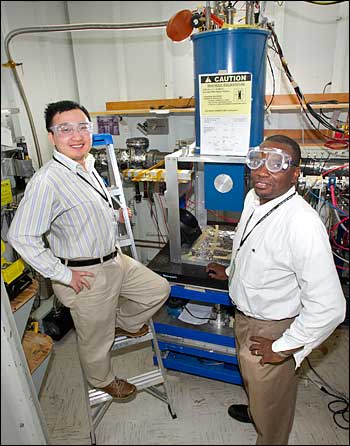Trevor Tyson Shines On
July 24, 2011

Trevor Tyson (at right) and NJIT graduate student Tao Wu at their group's cryomagnet system on NSLS beamline X19A.
Trevor Tyson was born on the tiny Caribbean island of St. Kitts and was raised on nearby St. Croix, which is equally small (both are less than 90 square miles in area). As he thinks about his current drive to work, he laughs that he logs more miles every day commuting one way than the entire 22-mile length of the island on which he grew up.
Tyson now lives in Mineola, New York, which lies about halfway in commuting time between NSLS, where he performs much of his research and helps run two beamlines, and the New Jersey Institute of Technology (NJIT) in Newark, New Jersey, where he is a physics professor. It has been 15 years since Tyson arrived at NJIT and became an NSLS user, and in that time he has built a very successful research program that spans both facilities. In fact, Tyson holds the record for the most beamlines used, having performed research or been the principal investigator on at least 20!
But, like many scientists, before Tyson settled in at NJIT and NSLS, he jumped around a few times. He earned his Ph.D. in experimental and theoretical condensed matter research at Stanford University in California, but during that time he did quite a bit of traveling to Frascati, Italy. Frascati is the home of Italy's national nuclear physics research center, the INFN, with which his Stanford research group was affiliated and where the former ADONE-Light synchrotron was located. After completing research at the Stanford Synchrotron Radiation Lightsource (SSRL), working under professors Keith Hodgson and Sebastian Doniach, he took a postdoctoral position at ADONE with one of the world's top experimental and theoretical x-ray spectroscopy groups, headed by Calogero Natoli.
When his time in Frascati was up, he took another post-doctoral position at Los Alamos National Laboratory (LANL). He spent two years there, making frequent trips back to Stanford to perform research at SSRL. His work during that period involved the study of complex oxides, a class of materials that have interesting electronic properties and may eventually be used in a new generation of computer hard drives.
After he was hired at NJIT in 1996, Tyson knew he wanted to build his own research group, a unique program that would combine studies of materials synthesis, modeling, and high-pressure transport studies at NJIT with experiments at NSLS. His experiences at NSLS, where he began working with Chi-Chang Kao (former NSLS chair and current SSRL director), were extremely positive from day one.
“I discovered that there were so many tools to work with, so many techniques to try,” he says. “And the people there are so open that if you have an idea of what you want to work on, they really support it.”
He also remembers being impressed with the broad range of science being conducted using the full spectrum of light produced at the facility, from infrared light to hard x-rays. “Every time I went there, I learned something new,” he says. “I really wanted to combine various methods to see materials from different perspectives.” The strong support and “can do” attitude of the NSLS staff reinforced this belief. It also encouraged him to learn and use multiple experimental methods.
Tyson has made steady progress ever since, with no signs of slowing down. He has created the successful research group he first envisioned, becoming one of the world's top experts in studies of atomic, magnetic, and electronic structure of correlated electron systems – materials that display unique and intriguing behavior due to the interactions between electrons. Just two years into his work at NJIT, in 1998, he received the prestigious National Science Foundation Faculty Early Career award. This has led to continued support by the National Science Foundation and the U.S. Department of Energy in the years to follow.
Via Tyson's group, NJIT jointly operates two NSLS beamlines, X11A (run by Brookhaven National Laboratory, the Canadian Light Source, the Naval Research Laboratory, the Naval Surface Warfare Center, and NJIT) and X14A (run by NJIT and the New York State College of Ceramics).
He and his group – four graduate students and two postdoctoral researchers – develop instrumentation for both laboratories and synchrotrons, combining this experimental work with theoretical modeling. Over the years, the group has assembled a clear picture of the microscopic origin of macroscopic phenomena like magnetism, ferroelectricity, and superconductivity in complex metal oxides. The group has also revealed the basic atomic structure of graphene-like systems utilizing the full spectrum of light produced at NSLS.
When NSLS shuts down in a few years, Tyson will move his research to its successor, NSLS-II, where he and his collaborators are already planning beamlines that will expand upon their NSLS work, ultimately gathering detailed structural measurements from samples subjected to high pressures and magnetic fields, over a broad temperature range.
This work will lead to the development of theoretical models to explain and predict properties that are beyond the scope of current physical models. Tyson is leading the effort to develop an NSLS-II beamline that will have the potential to make great progress in high-magnetic-field research and will foster the development of new types of magnets, detectors, x-ray optical instruments, and high-pressure measurement methods.
— Laura Mgrdichian, Photon Sciences Science Writer
2011-2535 | INT/EXT | Newsroom









